My special
thanks to Roy W0SL, Jim N4ST, Don KD4APP, Darrel AA7FV,
Jim N5JDB, Clive G3CWV, Mike DK3WN, Reinhard DJ1KM +,
Michael DG1CMZ, Oliver DG6BCE, Peter DF2JB, Volker DF7IT,
Jean-Louis F6AGR, Thomas HB9SKA, Christoph HB9HAL, Claudio
IK1SLD, Andreas OE1DMB, Michael PA3BHF, Henk PA3GUO,
Darek SP9TTX, Ricardo PY3VHQ, Keith ZS6TW, Don N4UJW,
Vladimir RA3DQT, Paulo CT1ETE, John KD2BD, Harald DH8HHA,
Maik Hermenau, Ian ZL1AOX, Gerd DL8DR, Michael OH2AUE,
Robert G8ATE, Wouter Jan Ubbels PE4WJ, Mark KF6KYI,
Al W8KHP, Drew KO4MA, Rolf DK2ZF, Dave WB6LLO, Graham
G3VZV, Joe K0VTY, Nils von Storch, Zeljko 9A2EY, Pierre
ZS6BB, Bent OZ6BL, Mariano CT1XI, Al GM1SXX, Luc LU1FAM,
Matt SQ7DQX, Lance K6GSJ, Chris VK3AML, Bob VE6BLD,
Sergej RV3DR, Alex VK5ALX, Rudolf ZS6FX, Dick Daniels
W4PUJ/SK , Bob Patterson K5DZE, Jean-Louis Rault F6AGR,
Ivano Bonesana, Patrick Hajagos, Luc Leblanc VE2DWE,
Mike N1JEZ, John K6YK, Tetsu-san JA0CAW, Marco Bauer,
Carl Lindberg SM6NZV, Philip G0ISW, Kuge-san JE1CVL,
Pat AA6EG, John M0UKD, Paul Marsh M0EYT, Federico Manzini,
Jan PE0SAT, Domenico I8CVS +, Roland Zurmely PY4ZBZ,
Rob Hardenberg PE1ITR, Michael Kirkhart KD8QBA, Davide
D'Aliesio IW0HLG, Francisco EA7ADI, Kubota-san, Noguchi-san
JA5BLZ, Kuge-san JE1CVL, Luciano PY5LF, Wakita-san JE9PEL,
Peter ON4EZJ, Enrico IW2AGJ, Jean-Pierre F5YG, Remco
PA3FYM, Dave G0CER, Jose Maria EA2JX, Viljo ES5PC, Charly
DK3ZL, Bernd DL6IAN, Gustavo LW2DTZ, Juergen DL8SDQ,
Gary ZS6YI, Wilhelm DL6DCA, Bence Szabo, Alex KR1ST,
Branko 9A3ST, Daniel DL7NDR, Michael Hoerenberg, Igor
PU4ELT, Tom SP5LOT, Nina DL2GRC and Udea san JA0FKM
for kindly contributing to this collection ! |
Picture |
Satellite
#NORAD |
Description |
Launch Date |
 |
FO-99
Fuji-OSCAR 99
NEXUS
#43937
(2019-003F) |
NExt generation X Unique
Satellite NEXUS is a Japanese satellite launched on
January 18th 2019 at 00:50
UTC on an Epsilon rocket from Uchinoura Space Centre.
The 1U Cubesat was built by Nihon University. Mid of
2021 operations of FO-99 was transferred from Nihon
University to JAMSAT.
Its linear transponder
and data frequencies are:
Uplink:
145.900-145.930 MHz (CW/LSB)
Downlink:
435.880-435.910 MHz (CW/USB)
CW/Data:
435.900 MHz & 437.075 MHz
Callsign:
JS1YAV
The CW beacon has been successfully
received on 437.0732 MHz. |
Jan
18th 2019 |
 Jean-Pierre
F5YG received the CW downlink signal of NEXUS during
its orbit #354 on February 10th
2019. Recording kindly provided by Jean-Pierre F5YG. Jean-Pierre
F5YG received the CW downlink signal of NEXUS during
its orbit #354 on February 10th
2019. Recording kindly provided by Jean-Pierre F5YG.
|
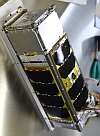
|
FO-98
Fuji-OSCAR 98
OrigamiSat-1
#43933
(2019-003B) |
Origami is one of Japan's
traditional paper-craft arts, the art of folding paper.
OrigamiSat-1 is a 3U Cubesat and
part of the ORIGAMI project (ORganizatIon of research
Group on Advanced deployable Membrane structures for
Innovative space science).
The solar power array and
the planar antenna realized on a thin film, by the
boom-film composite structure that allows weight
reduction and high collection rate of major structural
(ORIGAMI Project proposal) "Multifunctional
developing membrane structure" universe demonstrate
to. (Multi-function film deployment mission)
3U to allow space experiments
of various deployable structure on the CubeSat,
to build the "experiment platform" to
continue developing technologies that take advantage
of the continuous universe demonstrate in the future,
perform the universe demonstrated. (Of OrigamiSat-1
of 3U, experimental platform portion 2U size specimen
is 1U size.) (Space proof platform development Mission)
So far to establish the
amateur radio satellite communication technology
in the 5.8GHz band, which has not been much use,
to contribute to the spread of the same frequency
band. Further to realize an antenna sticking into
the thin film. (Amateur radio Mission)
The downlink frequencies are 437.505
MHz (1200bps AFSK, CW)
and 5840 MHz (115 kbps). |
Jan
18th 2019 |
 Jean-Pierre
F5YG received the CW downlink signal of Origamisat-1
during its orbit #49 on January 21st
2019. Recording kindly provided by Jean-Pierre F5YG. Jean-Pierre
F5YG received the CW downlink signal of Origamisat-1
during its orbit #49 on January 21st
2019. Recording kindly provided by Jean-Pierre F5YG.
|
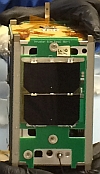
|
NO-103
Navy-OSCAR 103
BRICSAT 2
USNAP1
#44355
(2019-036V) |
BRICSat
2 (Ballistically Reinforced Communication Satellite)
is a low cost 1.5U CubeSat built by the US Naval Academy
Satellite Lab in collaboration with George Washington
University, that will demonstrate on-orbit operation
of a Micro-Cathode Arc Thruster (µCAT) electric
propulsion system and carries an Amateur communication
payload as a follow on to BRICSat-P (BRICSat 1). Four
µCAT offset thrusters can both change the attitude
of BRICSAT-2 but also do some orbit maneuvering. BRICSat-2
has a Amateur communication payload on boards. An APRS
constellation transponder with a telemetry downlink
on 437.975 MHz and with packet up- and downlinks on
145.825 MHz 1k2 and 9k6 AX25.
I am searching
for sound files. Please send them to
 |
June 25th
2019 |
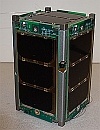
|
NO-104
Navy-OSCAR 104
PSAT2
ParkinsonSAT
#44354
(2019-036U) |
PSat
2 (ParkinsonSAT) is a student satellite project which
is a two way communications transponder for relaying
remote telemetry, sensor and user data from remote environmental
experiments or other data sources back to experimenters
via a global network of internet linked volunteer ground
stations. The data transponder also includes all telemetry,
command and control for this 1.5U CubeSat.
The
unique features of PSAT-2 are the APRS transponder and
the PSK31 transponder, both of which flew on PSAT-1
and the new APRStt (TouchTone)/Voice transponder, for
which a prototype flies on the eXCITe (QIKCOM-2) satellite,
which lets everyone do APRS using any radio with DTMF
keypad, not just those with APRS radios. in addition
it features a SSTV (Robot-36 format) downlink.
The
frequencies are:
145.825 MHz – Uplink
und Downlink APRS-Digipeater, 1200 Baud
435.350 MHz – Downlink
PSK31 und SSTV
29.4815 MHz – Uplink
PSK31
The
callsign of PSAT2 is PSAT2-1 when it is in safe-mode
with the DIGI switched off and the callsign is PSAT2
when the digi is on. |
June
25th 2019 |
  Enclosed
SSTV transmission of PSAT-2 was received and decoded
on September 30th 2019 at 21:01
UTC by Igor PU4ELT. Enclosed
SSTV transmission of PSAT-2 was received and decoded
on September 30th 2019 at 21:01
UTC by Igor PU4ELT.
Recording and picture kindly provided
by Igor PU4ELT. |
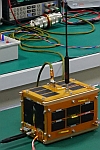
|
BO-102
BIT Progress OSCAR 102
CAS-7B
BP-1B
#44443
(2019-042C) |
CAS-7B
(BP-1B) was launched on July 25th
2019 by a Hyperbola-1 launch vehicle from the Jiuquan
Space Center, China into a circular orbit with a height
of 300km and an inclination of 42.7 degree. This microsatellite
was developed by the Chinese Amateur Satellite Group
(CAMSAT) in cooperation with the Beijing Institute of
Technology (BIT). CAMSAT completed the project planning,
design, build, and testing, and manages the on-orbit
operation of the satellite. BIT provided the satellite
environmental testing, launch support, and financial
support. Many students from BIT were involved in the
project, learning about satellite technology and amateur
radio. The satellite carries a CW telemetry beacon and
FM repeater that has been active since launch. Because
of the orbital apogee and the size and mass of the satellite,
the orbital life of the satellite is expected to be
only one week, up to a maximum of one month, which will
also provide with an opportunity for hams to track and
monitor satellite entering the atmosphere.
The CW telemetry
beacon us transmitting on 435.715 MHz (100mW).
The
V/U FM transponder uplink frequency is 145.900 MHz.
The V/U FM transponder downlink frequency is 435.690
MHz (100mW)
BO-102 decayed
on August 6th 2019. |
July
25th 2019 |
 Luciano
PY5LF operated via BO-102 on July 28th
2019 at 17:36 UTC. Recording kindly provided by Luciano
PY5LF. Luciano
PY5LF operated via BO-102 on July 28th
2019 at 17:36 UTC. Recording kindly provided by Luciano
PY5LF.
|
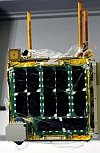
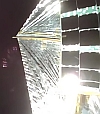
|
TAURUS-1
Jinniuzuo 1
44530
(2019-059C) |
TAURUS-1
is a 10kg nano-satellite built by Shanghai Aeros Aerospace
Science and Technology Co. Ltd. and launched on the
CZ-4B rocket from Taiyun Satellite Launch Center into
a circular orbit with an altitude of 740km and an inclination
of 98.6 degree.
The primary purpose is to test a
2.5m2 drag sail to accelerate
de-orbiting.
TAURUS 1 also carries an analog FM
to digital voice CODEC-2 (9600bps BPSK) V/U repeater.
The FM uplink frequency is 145.820 MHz, a 67Hz CTCSS
is needed. The CODEC-2 and the telemetry downlink frequency
is 435.8389 MHz. TAURUS-1 uses the same protocol as
LO-90 (LilacSat-1).
I am searching
for sound files. Please send them to
 |
Sept. 12th
2019 |
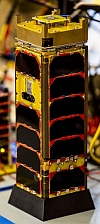
|
HO-107
HuskySat-OSCAR 107
HuskySat-1
#45119
(2019-071J) |
HuskySat-1
is a 3U Cubesat designed by Husky Satellite Lab, a registered
student group, in Johnson Hall at University of Washington,
Seattle, USA. It was launched on November 2nd
2019 by Cygnus NG-12 from Mid-Atlantic Regional Spaceport
Launch Pad 0 on Wallops Island, Virginia to low earth
orbit. It was released from Cygnus on January 31st
2020 and started its operations shortly after.
Huskysat-1 will
demonstrate onboard pulsed plasma thruster (PPT) and
high gain telemetry for low Earth orbit that would be
a precursor for an attempt at a larger CubeSat designed
for orbital insertion at the Moon.
The satellite will
also test an experimental 24GHz data transmitter.
Furthermore it
features an inverting V/U linear transponder with a
bandwidth of 30 kHz. It was opened for general use on
May 10th 2020. The uplink is
from 145.910 to 145.940 MHz, the downlink is from 435.810
to 435.840 MHz.
The UHF 1200bd
BPSK telemetry downlink frequency is 435.7997 MHz. |
Nov
2nd 2019 |
 On May
11th 2020 at 23:56 UTC Zeljko
9A2EY and Charly DK3ZL hat a successful contact via
HO-107. Recording kindly provided by Charly DK3ZL. On May
11th 2020 at 23:56 UTC Zeljko
9A2EY and Charly DK3ZL hat a successful contact via
HO-107. Recording kindly provided by Charly DK3ZL.
|
 On May
12th 2020 also late at night
Jerome F4DXV and Charly DK3ZL hat a successful contact
via HO-107. Recording kindly provided by Charly DK3ZL. On May
12th 2020 also late at night
Jerome F4DXV and Charly DK3ZL hat a successful contact
via HO-107. Recording kindly provided by Charly DK3ZL.
|


|
MO-106
Magyar-OSCAR 106
ATL-1
#44830
(2019-084G) |
On
December 6th 2019 ATL-1, an
Hungarian 2P picosatellite developed by Advanced Technology
of Laser ATL Ltd. was launched on an Electron launch
vehicle from the Mahia Launch Complex in New Zealand.
SMOG-P and ATL-1 were developed as part of the university
curriculum and operated in cooperation with the HA5MRC
Technical University amateur radio club. The
satellites carry spectrum monitoring payloads and are
currently active.
Downlink
frequency is 437.175 MHz, modulation is 12500bps GMSK
I am searching
for sound files. Please send them to
 |
Dec 6th
2019 |
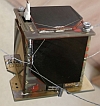
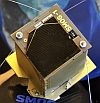
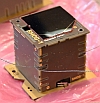
|
MO-105
Magyar-OSCAR 105
SMOG-P
#44832
(2019-084J) |
On
December 6th 2019 SMOG-P, an
Hungarian 1P picosatellite developed by the Technical
University of Budapest was launched on an Electron launch
vehicle from the Mahia Launch Complex in New Zealand.
SMOG-P and also ATL-1 were developed as part of the
university curriculum and operated in cooperation with
the HA5MRC Technical University amateur radio club.
The satellites
carry spectrum monitoring payloads and are currently
active.
Downlink
frequency is 437.1497 MHz, modulation is 12500bps GMSK.
I am searching
for sound files. Please send them to
 |
Dec 6th
2019 |

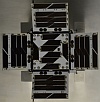

|
FOSSASAT-1
#44829
(2019-084F) |
Fossasat-1
is a 5cmx5cmx5cm Pocketcube satellite weighing only
250g. Its mission is to create the worlds first open
source IoT network via satellite. It features a LORA
repeater and RTTY transmitter. It transmits on 436.700
MHz. After launch it was found out, that the satellite
is working fine but that the antennas were not properly
deployed. This results in a very weak signal.
I am searching
for sound files. Please send them to
 |
Dec 6th
2019 |
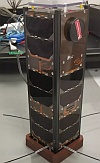
|
Duchifat
3
#44854
(2019-089C) |
Jointly built by
Herzliya Science Center and Sha’ar HaNegev High School
students, the Duchifat-3 satellite is designed to serve
children from across the country to “observe the Earth”.
It transmits 9600 bd telemetry on the downlink frequency
436.400 MHz.
FM
Repeater Downlink frequency is 436.420 MHz
FM
Repeater Uplink frequency is 145.970 MHz (no tone)
I am searching
for sound files. Please send them to
 |
Dec 11th
2019 |

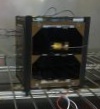
|
FloripaSat
1
#44885
(2019-093G) |
FloripaSat-1 is
a Brazilian Cubesat built by university students at
the Federal University of Santa Catarina (UFSC), Brazil.
One of the payload modules was developed at UNSW University
in Australia.
FloripaSat-1
features a 1200bd GFSK beacon with a deviation of 2.5kHz
and a downlink frequency of 145.90047 MHz. The output
power is 1W.
In
addition FLORIPSAT-1 tranmits data packets periodically
on 436.100 MHz. This downlink uses 2400 bps 2-GFSK modulation
with a deviation of 5kHz and a output power of 1W.
I am searching
for sound files. Please send them to
 |
Dec
18th 2019 |


|
TO-108
TQ-OSCAR 108
CAS-6
Tianqin 1
TQ-1
#44881
(2019-093) |
Tianqin
1/CAS 6 (Chinese Amateur Radio satellite 6) is a Chinese
technology development microsatellite for China's gravitational-wave-astronomy
program, which carries also a payload for amateur radio
communication and education. The satellite was built
by DFH Satellite Co. for Zhongshan Daxue (Sun Yat-sen
University) and Huahzhong University of Science and
Technology. It features a 49 cm × 50 cm ×
43 cm cubic body with body mounted solar cells and a
mass of approximately 35 kg. This microsatellite is
3 axis stabilized.
CAS6A was launched
on December 20th 2019 on a
CZ-4B launch vehicle from the Taiyuan Satellite Launch
Center, China, into a SSO orbit with an apogee of 629km
and inclination of 97.9 degrees.
The inverting
linear U/V transponder of CAS-6 with a bandwidth of
20 kHz, an uplink of 435.280 MHz and a downlink of 145.925
MHz was first time activated on June 20th
2020. The call sign is BJ1SO.
In addition
BJ1SO features a 4800bd GMSK AX.25 telemetry downlink
at 145.890 MHz and a CW beacon at 145.910 MHz.
Presently the
transponder operates with about 2 seconds on , 5 seconds
off. Investigations for the root cause are ongoing.
|
Dec
20th 2019 |
  On
July 2nd 2022 at 22:01 UTC
Michael Hoerenberg received the CW beacon of TO-108
on 145.910 MHz. The CW beacon is only transmitting the
first 3 characters of the callsign and then seems to
reset. You can see that nicely in the screenshot of
the audio signal above. Recording kindly provided by
Michael Hoerenberg. On
July 2nd 2022 at 22:01 UTC
Michael Hoerenberg received the CW beacon of TO-108
on 145.910 MHz. The CW beacon is only transmitting the
first 3 characters of the callsign and then seems to
reset. You can see that nicely in the screenshot of
the audio signal above. Recording kindly provided by
Michael Hoerenberg.
|
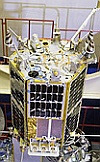 |
RS-44
DOSAAF-85
Radio-2017
#44909
(2019-096E) |
Constructed by specialists at Information
Satellite Systems and Students at Siberian State Aerospace
University, DOSAAF-85 was launched together with 3 Gonets
satellites and BLITS-M1 on a Rockot/Breeze-KM launch
vehicle from Plesetsk Cosmodrome on December 26th
2019. The satellite failed to separate from the upper
stage of the launch vehicle and remains attached. The
satellite’s name commemorates the 85th
anniversary of the Voluntary Society for the Assistance
to the Army, Aviation, and Navy (DOSAAF), the organization
responsible for the military training of Soviet youth.
Designated
RS-44, or Radio Sputnik 44, the satellite carries a
60 kHz wide inverting V/U linear transponder and a CW
beacon.
The
uplink and downlink frequencies of the inverting transponder
are:
Uplink: 145.935-145.995 MHz LSB
Downlink:
435.610-435.670 MHz USB
Beacon:
435.605 MHz CW
It
may also have a S-band downlink between 2400 and 2485
MHz.
With
an orbit of 1511 km x 1175 km and an inclination of
82.5 degrees, RS-44 is providing a nice footprint given
it is a LEO satellite.
The transponder
was first time activated on April 30th
2020 for a test period until May 11th
2020. It seems to work very well and hopefully will
stay active for a longer period of time. |
Dec
26th 2019 |
 On May
5th 2020 at 20:25 UTC Robert
DL5GAC and Charly DK3ZL hat a successful contact via
RS-44. Recording kindly provided by Charly DK3ZL. On May
5th 2020 at 20:25 UTC Robert
DL5GAC and Charly DK3ZL hat a successful contact via
RS-44. Recording kindly provided by Charly DK3ZL.
 Shortly
after, on May 5th 2020 at 20:32
UTC I received DL5GAC calling CQ and having another
QSO. As I was using only a short vertically polarized
omni-directional antenna the signals were quite weak
but readable. Shortly
after, on May 5th 2020 at 20:32
UTC I received DL5GAC calling CQ and having another
QSO. As I was using only a short vertically polarized
omni-directional antenna the signals were quite weak
but readable.
 During
the same path I also received some Italian stations
including Rocco in IN70VH and I95TEPM in a QSO. During
the same path I also received some Italian stations
including Rocco in IN70VH and I95TEPM in a QSO.
 Charly
DK3ZL also kindly sent me a recording of the CW beacon,
which he had received on May 5th
2020 at 14:30 UTC. Charly
DK3ZL also kindly sent me a recording of the CW beacon,
which he had received on May 5th
2020 at 14:30 UTC.
|

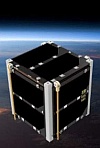
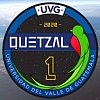
|
QUETZAL-1
#45598
(1998-067RL) |
Guatemala’s first satellite, a 1U CubeSat
called QUETZAL-1, was deployed from the International
Space Station (ISS) on Tuesday, April 28th
2020 using the Japanese KIBO module.
Its
primary mission is to test a sensor for remote data
acquisition for natural resource management, which could
be used to monitor water quality in inland water bodies.
The
satellite is part of the Japanese Kibo cubesat program,
a product of the cooperation between, among others,
the United Nations Office for Outer Space Affairs (UNOOSA),
Universidad del Valle de Guatemala (UVG), and more institutions.
The operational frequencies were chosen through cooperation
from Guatemalan radio amateurs and the International
Amateur Radio Union (IARU).
Downlink
4800 bps GMSK on 437.200 MHz. |
April
28th 2020 |
 PY4ZBZ
received and decoded the downlink signal of Quetzal-1
on April 28th 2020 at 14:07
UTC during its second orbit. Spectrum plot kindly provided
by Roland PY4ZBZ. PY4ZBZ
received and decoded the downlink signal of Quetzal-1
on April 28th 2020 at 14:07
UTC during its second orbit. Spectrum plot kindly provided
by Roland PY4ZBZ.
|
 On
September 12th 2020 from 00:11
to 00:22 UTC On
September 12th 2020 from 00:11
to 00:22 UTC
DD1US received Questal-1 with his
SatNogs station.
Enclosed please find the spectum
plot and the decoded
data.
|

|
BY70-3
BY70 3
Bayi-03
Taiyuan
NPUBY3
#46839
(2020-079N) |
BY70-3 or Taiyuan
is a microsat project led by China Center for Aerospace
Science and Technology International Communications
for school education and amateur radio. Students from
the Beijing Bayi High School built the satellite under
the instructions from experts.
BY 3 is a microsat
with less than 40 kg and 196×190×315 mm.
It is one of a series of public welfare science education
satellites launched by China center for Aerospace Science
and Technology International Communications in cooperation
with Taiyuan Jinshan Middle School and other schools,
which are not commercial sources of funds. It is aimed
at developing science education in space for primary
and secondary school students around the world. In order
to facilitate the operation and practice of students
from all over the country and the world, the satellite
plans to set up a space amateur frequency band communication
payload for students to understand and practice the
principle of satellite operation and control.
The satellite was
launched on November 6th 2020
on a CZ-6 rocket from Taiyuan Satellite Launch Center
/ China as a piggy-back payload.
BY70-3 decayed on
April 8th 2023. |
Nov.
6th 2020 |
 On October
30th 2022 at 10:22 UTC Daniel
DL7NDR received on 437.600 MHz the 9600bd BPSK beacon.
Recording kindly provided by Daniel DL7NDR. On October
30th 2022 at 10:22 UTC Daniel
DL7NDR received on 437.600 MHz the 9600bd BPSK beacon.
Recording kindly provided by Daniel DL7NDR.
|
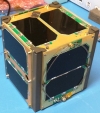

|
AO-109
RadFxSat-2
Fox-1E
#47311
(2021-002C) |
RadFxSat-2 was launched
on January 17th 2021 on a LauncherOne
vehicle.
The
satellite carries a telemetry beacon and a linear transponder.
Its
beacon downlink is supposed to be at 435.750 MHz and
the linear transponder downlink 435.760-435.790 MHz.
The
beacon was never heard but there were a few reports
that weak downlink signals were heard on the transponder.
I
have contacted those reporters and the responsible people
at AMSAT-NA and asked for recordings to add them to
this collection but never received any answer.
After
6 months, on July 20th 2021, the satellite
was officially released for general use .Maybe now audio
recordings might become available.
I am searching
for sound files. Please send them to
 |
Jan 17th
2021 |

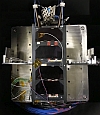


|
OPUSAT-2
Hirogari
#47930
(1998-067SG) |
OPUSAT-2 (Osaka
Prefecture University Satellite) or Hirogari is a 1.4KG
nanosatellite that was developed by Osaka Prefecture
University. It was
developed based on the earlier OPUSAT. The
2U Cubesat was launched on board of Cygnus CRS-15 on
an Antares-230+ rocket and was thus delivered to the
ISS, from where it was deployed via the JEM airlock.
OPUSAT 2 has two
main missions:
The first mission
is to demonstrate high-speed data transmission in amateur
radio band. The satellite communication system's design
and the results of the experiment will be made public.
The second mission
is a deployment of a large folded structure. A deployable
plastic plate is stored inside the satellite, based
on Miura fold. The folding method that will be tested
in this mission takes into account the thickness of
the plate, unlike the traditional Miura fold. The satellite
will optically measure the deployment using a pair of
cameras. The team proposes applying this folding method
on space-based solar power in the future.
Hirogari uses the
following amateur radio frequencies and modes:
Downlinks:
145.900 MHz - CW beacon
145.900 MHz - AFSK 1200bd
AX.25 / GMSK 9600-13653bd AX.25
Uplink:
436.500
MHz - AFSK 1200bd AX.25 |
Feb
10th 2021 |
 On February
10th 2022 at 09:35 UTC Patrick
Hajagos received the downlink signal of OPUSAT-II on
145.898410MHz in CW.. Recording kindly provided by Patrick
Hajagos. On February
10th 2022 at 09:35 UTC Patrick
Hajagos received the downlink signal of OPUSAT-II on
145.898410MHz in CW.. Recording kindly provided by Patrick
Hajagos.
|
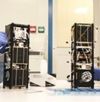
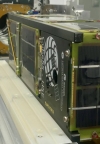
|
CubeSX-HSE
MIEM 3U
NRU HSE-DZZ
RS13S
#47952
(2021-022X) |
CubeSX-HSE is the
first satellite of High School of Economics “NIU VShE
— DZZ”. The 3U CubeSat has a weight of 3.5kg and is
equipped with an experimental camera based on the stepped
(Fresnel) lenses developed by the Samara University,
and with a high-speed X-band transmitter.
CubeSX-HSE is transmitting
on 435.650 MHz in 2400/9600bd GMSK.
It also transmits
on 10455 MHz in DVB-S2. |
Mar
22th 2021 |
 On November
4th 2022 at 10:05 UTC Daniel
DL7NDR received on 435.650 MHz the 2400bd GMSK beacon.
Recording kindly provided by Daniel DL7NDR. On November
4th 2022 at 10:05 UTC Daniel
DL7NDR received on 435.650 MHz the 2400bd GMSK beacon.
Recording kindly provided by Daniel DL7NDR.
|

|
CubeSX-Sirius-HSE
Sirius-DZZ
SiriusSat 3U
RS14S
#47951
(2021-022W) |
CubeSX-Sirius-HSE
is a 3U CubeSat of Sirius Center and NRU HSE. The spacecraft
is equipped with an improved DeCor-type instrument to
monitor quick changes in the space radiation fluxes.
Researchers from the Sirius University and the Moscow
University’s Scientific and Research Institute of Nuclear
Physics are in charge of the project’s scientific component
– handling the space radiation detector and mission’s
mathematical algorithms.
CubeSX-Sirius-HSE
is transmitting on 437.050 MHz in 2400/9600bd GMSK.
It also transmits
on 10465 MHz in DVB-S2. |
Mar
22th 2021 |
 On November
26th 2022 at 22:29 UTC Daniel
DL7NDR received on 437.050 MHz the 2400bd GMSK beacon.
Recording kindly provided by Daniel DL7NDR. On November
26th 2022 at 22:29 UTC Daniel
DL7NDR received on 437.050 MHz the 2400bd GMSK beacon.
Recording kindly provided by Daniel DL7NDR.
|
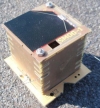
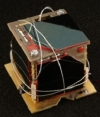
|
MO-110
Magyar-OSCAR 110
SMOG-1
Zsebi
#47964
(2021-022AJ) |
SMOG-1,
is a PocketQube built by the Budapest University of
Technology and Economics. SMOG was launched on March
22nd 2021 on a Soyuz-2-1a Fregat
launch vehicle from Baikonur, Kazakhstan. SMOG-1 has
a size of 5cm x 5cm x 5cm and carries RF spectrum monitoring
experiment measuring the signal levels of digital terrestrial
TV transmitters in the frequency range 460-860 MHz.
and total ionizing radiation experiments.
SMOG-1
carries a 100mW transmitter with a downlink frequency
of 437.345 MHz. Its modulation is 12500bps 2-GMSK. In
addition it features a CW morse code telemetry downlink
at the same frequency transmitting the callsign, battery
voltage and temperature. |
Mar
22nd 2021 |
 On August
2nd 2021 at 09:12 UTC Bence
Szabo from Nove Zamky in Slovakia received the downlink
signal of SMOG-1. Bence was using a 5 element yagi and
a RTL-SDR dongle for the reception. Recording kindly
provided by Bence Szabo. On August
2nd 2021 at 09:12 UTC Bence
Szabo from Nove Zamky in Slovakia received the downlink
signal of SMOG-1. Bence was using a 5 element yagi and
a RTL-SDR dongle for the reception. Recording kindly
provided by Bence Szabo.
|
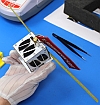


|
DO-111
DIY-OSCAR 111
DIY-1
ARDUIQUBE
#47963
(2021-022AH) |
DIY-1, a
PocketQube built by DIY in Argentina, was launched on
March 22nd 2021 on a Siyuz-2-1a
Fregat rocket from Baikonur/Kazakhstan into a polar
orbit with apogee of 560km and a perigee of 530km. DO-111
has a size of 5cm x 5cm x 5cm and a weight of 125g.
DIY-1 carries a deorbiting experiment and a telemetry
beacon on 437.125 MHz transmitting 100BD RTTY 7N2, 500bd
FSK and CW signals. The output power can be adjusted
to 25/50/100mW. The antenna is a dipole antenna. |
Mar
22nd 2021 |
 On April
16th 2021 at 10:08 UTC Gustavo
LW2DTZ received the RTTY beacon of DY-111. Recording
kindly provided by Gustavo LW2DTZ. On April
16th 2021 at 10:08 UTC Gustavo
LW2DTZ received the RTTY beacon of DY-111. Recording
kindly provided by Gustavo LW2DTZ.
|
 On May
12th 2021 at 04:49 UTC Gustavo
LW2DTZ received the 500bd FSK beacon of DY-111. Recording
kindly provided by Gustavo LW2DTZ. On May
12th 2021 at 04:49 UTC Gustavo
LW2DTZ received the 500bd FSK beacon of DY-111. Recording
kindly provided by Gustavo LW2DTZ.
|
  On March
22nd 2022 at 21:54 Michael
Hoerenberg received the CW beacon of DO-111 on 437.125
MHz. You can see the decoded telemetry included in the
screenshot of the audio signal above. Recording kindly
provided by Michael Hoerenberg. On March
22nd 2022 at 21:54 Michael
Hoerenberg received the CW beacon of DO-111 on 437.125
MHz. You can see the decoded telemetry included in the
screenshot of the audio signal above. Recording kindly
provided by Michael Hoerenberg.
|


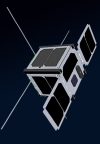
|
MO-112
MIRSAT-OSCAR 112
MIRSAT-1
MIR-1
#48868
(1998-067SP) |
MIRSAT-1
(Mauritius Imagery & Radio-communication SATellite
1) is the first Mauritian (3B8) satellite. It was sent
to the ISS on SpaceX resupply mission 22 on June 3rd 2021 and deplyed
by the KIBO robotic arm on June 22nd 2021.
Payloads are a camera and a digipeater
(bent pipe) which will be made available to the HAM
community worldwide when the satellite is not transmitting
images or used for experimental purposes.
The uplink frequency is 145.9875
MHz and the downlink frequency is 436.925 MHz, 19K2
GMSK, as coordinated with IARU. |
June
22nd 2021 |
  On June
23rd 2021 at 10:36 UTC DD1US
received the downlink signal from MIRSAT-1 on 436.925
MHz using his SatNogs station. The audio recording is
cropped. You can hear the short burst of the 19k2 downlink
signal about 18 seconds after the start of the recording. On June
23rd 2021 at 10:36 UTC DD1US
received the downlink signal from MIRSAT-1 on 436.925
MHz using his SatNogs station. The audio recording is
cropped. You can hear the short burst of the 19k2 downlink
signal about 18 seconds after the start of the recording.
|

|
HO-113
HOPE-OSCAR 113
CAMSAT XW-3
CAS-9
#50466
(2021-131B) |
XW-3 (CAS-9) is
a 6U Cubesat with a total weight of 10kg and was launched
on December 26th 2021
on a CZ-4C rocket from the Taiyuan Satellite Launch
Center, China into a sun-synchronous low earth orbit
with an altitude of 770km and an inclination of 98.6degree.
XW is the abbreviation for Xiwang and means hope.
This satellite was
developed by the Chinese Amateur Satellite Group (CAMSAT)
in cooperation with the Chinese government’s aerospace
and education departments, and is used to provide services
to amateur radio enthusiasts around the world and to
educate students in science and technology. CAMSAT completed
the design and manufacture of the amateur radio payload
and manages the satellite in-orbit operation.
The ham radio payload
consists of:
- VHF and UHF 1/4 wavelength whip antennas
- CW
telemetry beacon:
Frequency 435.575MHz, 20dBm,
CW
rate 22wpm
- GMSK
telemetry beacon:
Frequency 435.725MHz, 23dBm,
data
rate: 4800bps
- Inverting V/U mode linear
transponder with 30kHz bandwidth:
Uplink
center frequency: 145.870MHz
Downlink center
frequency: 435.180MHz
Output oower: 20dBm
-  Camera
for the visible spectrum: Camera
for the visible spectrum:
Images from the camera
can be downloaded. A download is triggered by an uplink
signal on 145.985MHz (FM, frequency deviation 3kHz,
DTMF).
|
Dec
26th 2021 |
 On February
6th2022 around 11:55UTC Branko
9A3ST in Labin/Croatia received the CW beacon from HO-113.
Recording kindly provided by Branko 9A3ST On February
6th2022 around 11:55UTC Branko
9A3ST in Labin/Croatia received the CW beacon from HO-113.
Recording kindly provided by Branko 9A3ST
|
  On July
1st 2022 at 22:16 UTC Michael
Hoerenberg received the CW beacon of HO-113 on 435.575
MHz. You can see the decoded telemetry included in the
screenshot of the audio signal above. Recording kindly
provided by Michael Hoerenberg. On July
1st 2022 at 22:16 UTC Michael
Hoerenberg received the CW beacon of HO-113 on 435.575
MHz. You can see the decoded telemetry included in the
screenshot of the audio signal above. Recording kindly
provided by Michael Hoerenberg.
|
 On April
18th 2022 at 11:50 UTC Daniel
DL7NDR received on 435.725 MHz the 4800bd GMSK beacon.
Recording kindly provided by Daniel DL7NDR. On April
18th 2022 at 11:50 UTC Daniel
DL7NDR received on 435.725 MHz the 4800bd GMSK beacon.
Recording kindly provided by Daniel DL7NDR.
|
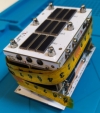

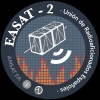
|
SO-114
Spain-OSCAR 114
EASAT-2
#51081
(2022-002DB) |
EASAT-2
was launched on a Falcon 9 rocket on January 13th
2022 into a low earth orbit. This PocketQube carries
an FM repeater with an uplink frequency of 145.875MHz
(FM voice without sub-tone or 50bps FSK) and a downlink
frequency of 436.666MHz (FM voice, CW, FSK 50bps, FM
voice beacon with AM5SAT callsign).
SO-114 decayed on or around May 25th
2024
I am searching
for sound files. Please send them to
 |
Jan 13th
2022 |

|
SO-115
Spain-OSCAR 115
HADES
#51080
(2022-002DA) |
HADES was
launched on a Falcon 9 rocket on January 13th
2022 into a low earth orbit. This 1.5P PocketQube carries
an FM repeater with an uplink frequency of 145.925MHz
(FM voice without sub-tone or 50bps FSK) and a downlink
frequency of 436.888MHz (FM voice, CW, FSK 50bps, FM
voice beacon with AM6SAT callsign).
SO-114 decayed on or around May 26th
2024
I am searching
for sound files. Please send them to
 |
Jan 13th
2022 |

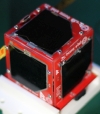
|
NO-116
Nepal-OSCAR 116
SANOSAT-1
Nepal PQ-1
#51031
(2022-002AZ) |
SANOSAT-1 (SANO means
small) was launched on a Falcon 9 rocket on January
13th 2022 into a low earth
orbit. This Picosat has a size of 5cm x 5cm x 5cm and
a weight of 250g.
Downlink and Beacon 436.235 MHz (500bps
GFSK, RTTY 45 Baud, CW 20 WpM)
Callsign AM9NPQ |
Jan
13th 2022 |
  On November
27th 2022 at 10:00 UTC Daniel
DL7NDR received on 436.235 MHz in LSB the RTTY beacon
as well a the 500bd GFSK beacon. Recordings kindly provided
by Daniel DL7NDR. On November
27th 2022 at 10:00 UTC Daniel
DL7NDR received on 436.235 MHz in LSB the RTTY beacon
as well a the 500bd GFSK beacon. Recordings kindly provided
by Daniel DL7NDR.
|
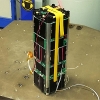


|
IO-117
Italy-OSCAR 117
GREENCUBE
#53106
(2022-080B) |
 GREENCUBE was launched on July 13th
2022 by ESA on a Vega-C launcher into a 5850km Medium
Earth Orbit (MEO). It is an Italian 3U cubesat. The
main mission is to grow plants in microgravity. For
amateur radio it includes a digipeater system supporting
real time and store-and-forward operation. Also pictures
of the Earth taken by an on-board camera can be downloaded. GREENCUBE was launched on July 13th
2022 by ESA on a Vega-C launcher into a 5850km Medium
Earth Orbit (MEO). It is an Italian 3U cubesat. The
main mission is to grow plants in microgravity. For
amateur radio it includes a digipeater system supporting
real time and store-and-forward operation. Also pictures
of the Earth taken by an on-board camera can be downloaded.
The digipeater of Greencube uses a frequency of 435.510
MHz GMSK 1k2 or 4k8.
|
July
13th 2022 |
 On August
14th 2022 around 06:35 UTC
Daniel DL7NDR received on 435.310 MHz the 1200bps GMSK
downlink. Recording kindly provided by Daniel DL7NDR. On August
14th 2022 around 06:35 UTC
Daniel DL7NDR received on 435.310 MHz the 1200bps GMSK
downlink. Recording kindly provided by Daniel DL7NDR.
|
 On October
1st 2022 around 14:25 UTC Daniel
DL7NDR received on 435.310 MHz the 300bps GMSK downlink.
Recording kindly provided by Daniel DL7NDR. On October
1st 2022 around 14:25 UTC Daniel
DL7NDR received on 435.310 MHz the 300bps GMSK downlink.
Recording kindly provided by Daniel DL7NDR.
|
 On January
6th 2023 around 19:45 UTC Daniel
DL7NDR received on 435.310 MHz in FM the 1200bps GMSK
digipeater downlink. Recording kindly provided by Daniel
DL7NDR. On January
6th 2023 around 19:45 UTC Daniel
DL7NDR received on 435.310 MHz in FM the 1200bps GMSK
digipeater downlink. Recording kindly provided by Daniel
DL7NDR.
|



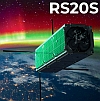
|
Geoscan
Edelveis
Geoskan Edleveis
RS20S
#53385
(2022-096R) |
On August 9th 2022
16 small spacecraft designed within the educational
project Space-pi, were launched
from Baikonur Cosmodrome on a Soyuz-2.1b rocket with
a Fregat upper stage into space. Among the secondary
payloads the 3U-Cubesat Geoscan-Edelveis designed in
St. Petersburg/Russia was included. Orbital characteristics
for the Geoscan-Edelveis spacecraft are an altitude
of 469?508 km (perigee and apogee) and an inclination
of 97 degree.
The primary mission
is to test a gas engine designed by the Experimental
bureau "Fakel" and an Elvis GNSS receiver.
Geoscan Edelveis
also carries a 10mmx15mm silicon wafer with 22772 names
from all over the world applied onto it by ion-beam
lithography.
The Geoscan-Edelveis
satellite downlink frequency is 436.200 MHz 9600/19200
bps GFSK in AX25 protocol. Using the callsign RS20S
it transmits telemetry and pictures, which were already
received by several radio amateurs around the world. |
Aug.
9th 2022 |
  On December
15th 2022 at 10:45UTC I received
the downlink signal on 436.200MHz using my Satnogs station.
Enclosed you can find a screenshot of the waterfall
and the audio recording. On December
15th 2022 at 10:45UTC I received
the downlink signal on 436.200MHz using my Satnogs station.
Enclosed you can find a screenshot of the waterfall
and the audio recording.
|
 On September
16th 2022 at10:03 UTC Daniel
DL7NDR received on 436.200 MHz the 9600bps GFSK beacon.
Recording kindly provided by Daniel DL7NDR. On September
16th 2022 at10:03 UTC Daniel
DL7NDR received on 436.200 MHz the 9600bps GFSK beacon.
Recording kindly provided by Daniel DL7NDR.
|
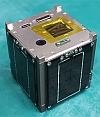
|
HSU-SAT
1
#53462
(1998-067UB) |
HSU-SAT 1 (Happy
Science University Satellite 1) is an educational 1U
CubeSat built by the Happy Science University in Chosei,
Chiba, Japan. The
satellite was delivered to the ISS on board of Dragon
CRS-25 on a Falcon-9 v1.2 (Block 5) rocket on July 15th 2022
and deployed
from the ISS via the "Kibo" JEM airlock on
Aug. 12th 2022.
The objectives of
the satellite are:
- A technology demonstration
of Electrical Power Supply On Board Computer and other
bus components.
- HSU-SAT1
performs three-axis attitude control by combining aerodynamic
stabilization and magnetic torquers.
- The
modulated infrared light emitted from the ground station
is experimented as command transmission link. The command
format conforms to the infrared remote-control system
used in electrical appliances.
- The camera
image is downlinked by Slow Scan Television (SSTV) in
FM modulation. The camera takes a photograph of the
Earth with a resolution of is 320×240 pixels.
Using the callsign
JS1YHS, HSU-SAT is transmitting a CW beacon on 437.280
MHz. The transmit power is 100mW. |
Aug.
12th 2022 |
 On November
23rd 2022 at 21:22 UTC Daniel
DL7NDR received on 437.280 MHz the CW beacon. Recording
kindly provided by Daniel DL7NDR. On November
23rd 2022 at 21:22 UTC Daniel
DL7NDR received on 437.280 MHz the CW beacon. Recording
kindly provided by Daniel DL7NDR.
|
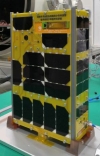

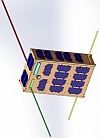

|
FO-118
Fengtai-OSCAR 118
CAS-5A
#54684
(2022-167C) |
On December 9th 2022,
the CAS-5A satellite was launched piggybacked on a
Smart Dragon-3 Y1 launch vehicle. The Chinese Amateur
Satellite Group (CAMSAT), working closely with local
education
authorities, designed, built, tested, and manages the
CAS-5A
satellite. Thirty-one students from ten high schools
learned satellite
design, manufacturing, and applications through educational
courses
initiated by CAMSAT and the Fengtai educational institution.
The
satellite uses the amateur radio callsign BJ1SO and
carries the following ham radio payloads:
V/U linear transponder:
-
Uplink
frequency: 145.820MHz
- Downlink frequency: 435.540MHz
- RF power: 23dBm
- Bandwidth: 30kHz
- Spectrum
inverted
H/U linear transponder:
-
Uplink
frequency: 21.435MHz
- Downlink frequency: 435.505MHz
- RF power: 23dBm
- Bandwidth: 15kHz
- Spectrum
normal
V/U
FM repeater:
-
Uplink
frequency: 145.925MHz
- Downlink frequency: 435.600MHz
- RF
power: 23dBm
- Bandwidth: 16kHz
CW
beacon:
-
Frequency:
435.570MHz
- RF
power: 20dBm
- CW
rate: 22wpm
GMSK
telemetry beacon:
- Frequency:
435.650MHz
- RF
power: 25dBm
- Data
rate: 4800/9600bps
Photo
download remote controlled:
- Frequency: 145.975MHz
- RF modulation: FM, frequency deviation 3kHz
-
Subcarrier DTMF (dual tone multi-frequency) |
Dec
9th 2022 |
 On
December 18th 2022 at 01:55UTC
I received the downlink signal on 435.600MHz using my
Satnogs station. Enclosed you can find a screenshot
of the waterfall. On
December 18th 2022 at 01:55UTC
I received the downlink signal on 435.600MHz using my
Satnogs station. Enclosed you can find a screenshot
of the waterfall.
|
 On December
10th 2022 around 14:25h UTC
Daniel DL7NDR received on 435.570 MHz the 4800bps GMSK
beacon. Recording kindly provided by Daniel DL7NDR. On December
10th 2022 around 14:25h UTC
Daniel DL7NDR received on 435.570 MHz the 4800bps GMSK
beacon. Recording kindly provided by Daniel DL7NDR.
|


|
HO-119
Hope-OSCAR 118
CAMSAT XW-4
CAS-10
#54816
(2021-035C) |
The CAMSAT XW-4 (CAS-10)
satellite was launched into the Chinese Space Station
on November 12th 2022 aboard
China's Tianzhou-5 cargo spacecraft, and was launched
by the Long March-7 Y6 launch vehicle from the Wenchang
Launch Center in Hainan, China. It is currently planned
that the XW-4 (CAS-10) satellite will be separated from
the Chinese space station and enter operational orbit
at 01:30 UTC on December 18th
2022.
The functions of XW-4 (CAS-10) satellite
include UHF CW telemetry beacon, GMSK telemetry data
transmission, V/U mode linear transponder and a visible
light band space camera.
After the satellite completes the
in-orbit test and works normally, the space camera photo
download will be open to amateur radio enthusiasts all
over the world. When the relevant remote control command
is received by the satellite, the GMSK telemetry channel
will be used to downlink the photo storage information
and photo data, and the telemetry data will stop sending
at that time.
XW-4(CAS-10) satellite adopts a 8U
CubeSat structure with a mass of about 12kg, an on-orbit
envelope size of 1007x790x475mm with four solar array
panels and a three-axis stabilized attitude control
system is used, long-term power consumption is about
18.3 Watts.
XW-4 Technical specifications are
as follows:
CW telemetry beacon:
- Frequency:
435.575MHz
- RF power: 20dBm
- CW rate:
22wpm
GMSK telemetry:
- Frequency: 435.725MHz
- RF power: 23dBm
- Data rate: 4800bps
V/U mode linear transponder:
- Uplink frequency:
145.870MHz
- Downlink frequency: 435.180MHz
- RF power: 20dBm
- Bandwidth: 30kHz
- Spectrum inverted
Photo download remote control |
Dec
18th 2022 |
 On December
18th 2022 around 12:25 UTC
Daniel DL7NDR received on 435.725 MHz the 4800bps GMSK
beacon. Recording kindly provided by Daniel DL7NDR. On December
18th 2022 around 12:25 UTC
Daniel DL7NDR received on 435.725 MHz the 4800bps GMSK
beacon. Recording kindly provided by Daniel DL7NDR.
|
Picture |
Satellite
#NORAD |
Description |
Launch Date |